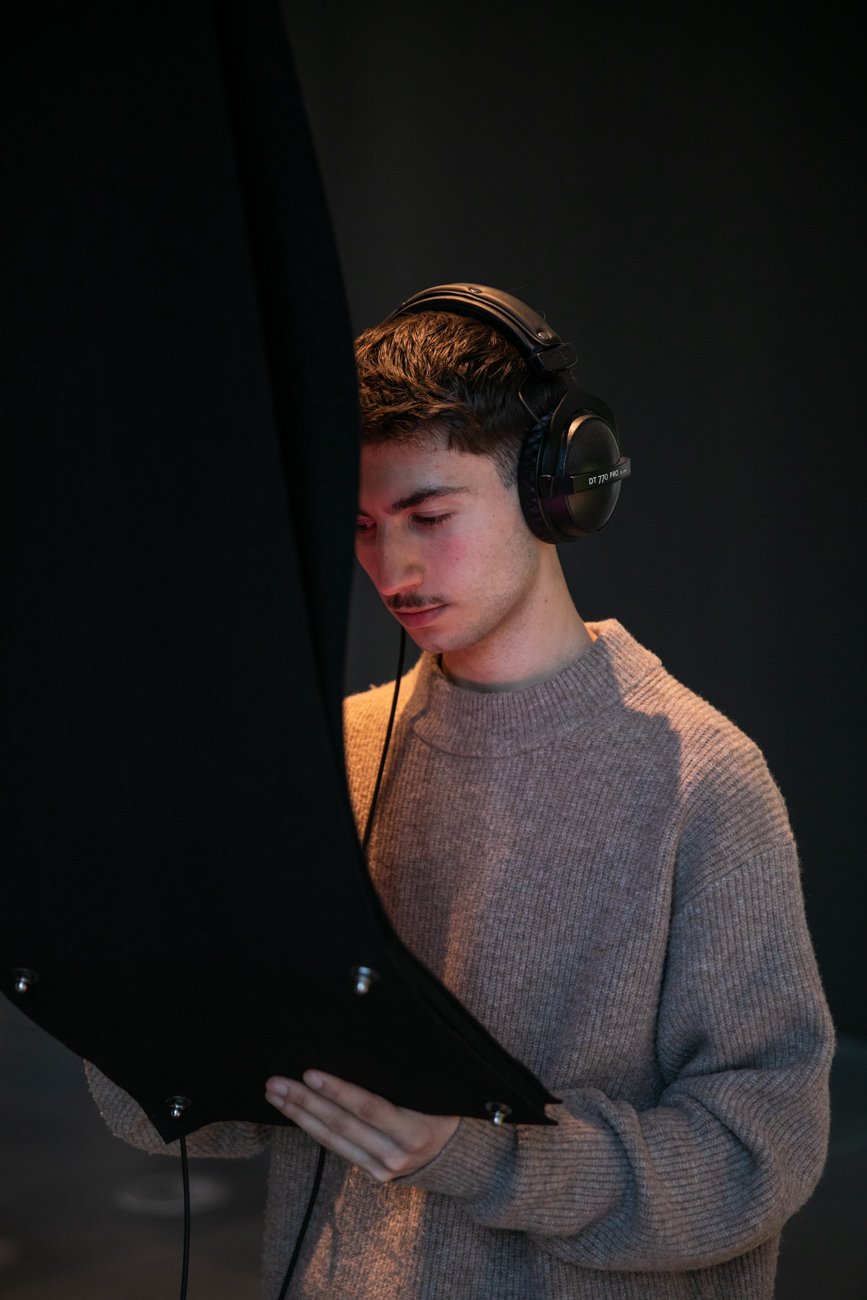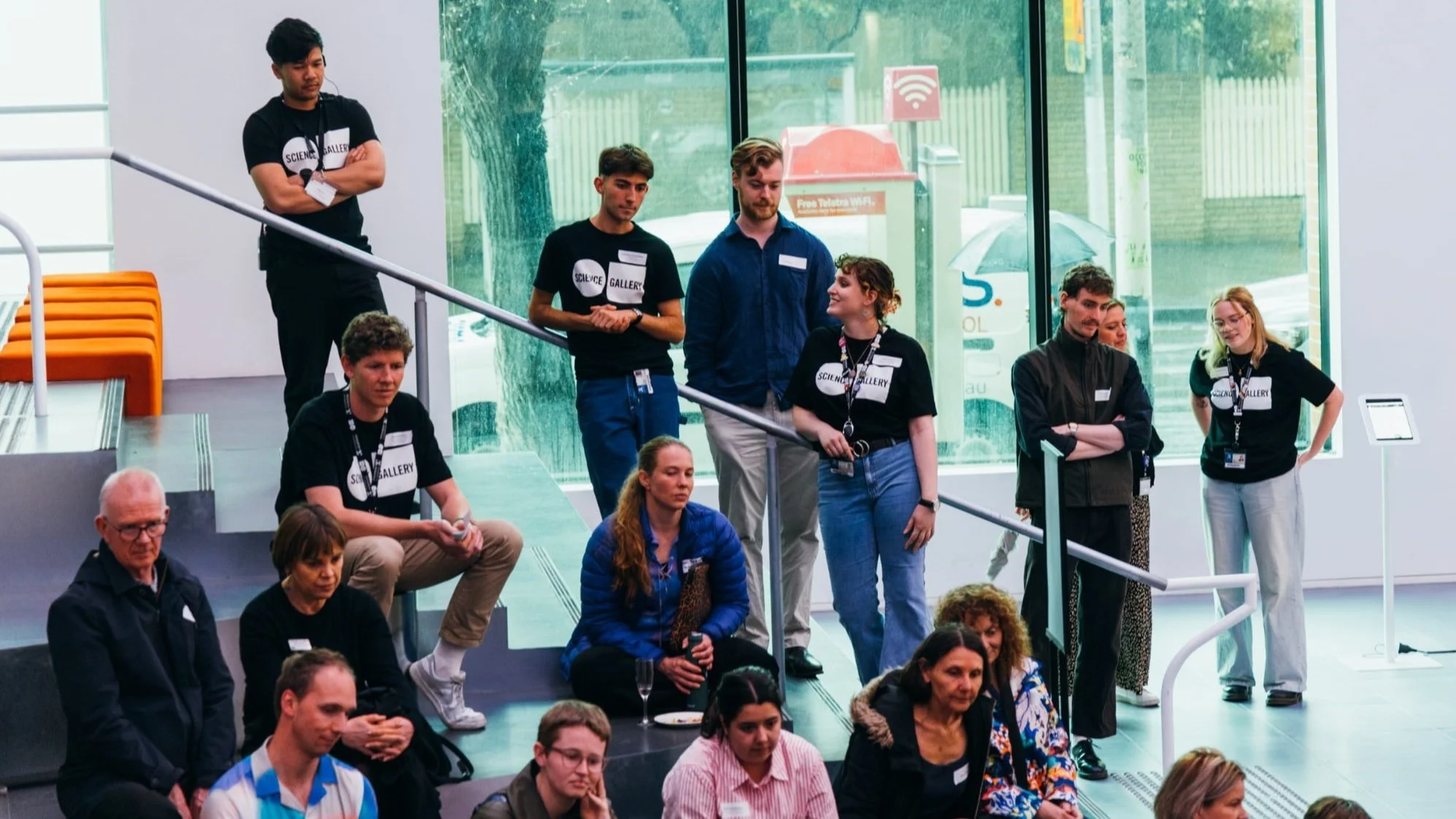Meet Christian from the Science Gallery Mediator team
Proudly supported by BASF, the Science Gallery Mediator program brings together a multi-talented team of young STEAM communicators who explore the themes in our exhibitions with our visitors. Christian shares what he loves about being a Mediator as he completes a Bachelor of Science (Honours) in the Infectious Disease Dynamics Unit.
Christian engaging with the exhibit Biophilia by Björk, Scott Snibbe Studio, and collaborators during the SWARM exhibition in 2022.
“I have developed the skills to get people on board and excited with weird and wacky ideas, infinitely useful in a world where scientists must prove the worth of their concepts in order to develop them. ”
Christian Theodosiou has been a Mediator since Science Gallery Melbourne found its permanent home in Melbourne Connect, joining the team for the exhibition MENTAL in 2022. He was completing his Bachelor of Science at the University of Melbourne, where he also contributed to Farrago Magazine as a photographer. At the time, Christian was working hospitality jobs, and volunteering with two organisations – In2Science (as a classroom mentor to secondary students in Victorian high schools) and Teddy Bear Hospital. Being a Mediator gave Christian the opportunity to develop his scientific communication skills and opportunities to explore new disciplines. This experience has led him to pursue a student research opportunity in epidemiology at the Infectious Disease Dynamics Unit, where he is currently writing his Honours thesis. Meanwhile, he continues to work in facilitating gallery learning experiences.
What is your favourite part of being a Mediator?
I love to immerse myself in the different exhibition themes at Science Gallery, which invariably exposes me to worlds of concepts previously unexplored, and ripe for conversation.
How is being a Mediator different from other jobs in the field?
In this space engagement with science differs dramatically from classroom models. Science Gallery is where we allow discussion to unlock the creative potential latent in science. Where the academic institution can feel stuffy, we bring an openness and curiosity to spark the interest of those who might not normally feel involved in these conversations.
Why is having young science communicators as the face of Science Gallery Melbourne so important?
It is important to me that University students and other young people have unique employment opportunities that align with their interests. Young science communicators positioned at the forefront of Science Gallery’s experience allows the wider public to engage with impassioned people across a range of disciplines and fascinating niches. Mediators not only bring younger people on board and encourage them to continue their learning and exploration of science, but engage in wider conversations of academia, and jump the generational gap by building rapport with visitors of all ages. Our model helps create a world where everyone brings their unique perspective to the conversation.
“I had a long conversation with a homeschooled secondary student who had resigned to the idea of further study, however our conversation enamored him to astrophysics and space exploration. Over a year later he returned on a school visit, remembered me, and excitedly told me about his admission into a diploma that would set him on a path towards a career in aeronautical engineering. ”
What has been your proudest moment as a Mediator?
We had a request to build a bespoke experience for faculty members from medicine, dentistry and health sciences at The University of Melbourne. The Dean of learning in this faculty gave us free reign to design an activity that would open the cohort to novel concepts and ways of learning. I had to put aside any desire to blatantly explain, and the result was a circuit activity that relied on close looking, and naive visual analysis of our exhibits. Our activity taught late-career medical professionals new ways to think and learn from the mysterious or abstract.
How do you engage with visitors who may have little to no background in science?
We use art, questioning, surprise and inquiry as the launch point for all sorts of conversations. I find it’s best to ask provoking questions that give people the space to reveal their opinions, and their level of understanding. From there, it is a matter of relying on the strategies that have made me enjoy learning in the past, to create new, surprising learning experiences for visitors. I’ve developed a stronger sense for finding the common ground that unites people, where the most all-encompassing conversations are bound to occur.
What impact do you hope to make through your work as a mediator?
I always endeavour to reveal people to the creative practice, patience, worldliness and curiosity that underpins scientific innovation. By engaging in diverse practices, stopping to learn from very different people, and basking in the grey areas, I hope that we dispel rigid notions of what scientific people and scientific careers can be.
Christian and other Mediators at a Science Gallery talk
How do you collaborate with other mediators at Science Gallery Melbourne?
Exchanging information and experiences with other mediators makes for a culturally rich workplace. We spend time trading gems of our disciplines, which has opened me to reams of new knowledge. Other mediators are often the people I turn to for advice, guidance, and just generally fascinating conversations. Mediating in pairs can be a great exercise in exciting debate, and dual perspectives.
BENEFITS AND IMPACTS
Knowledge sharing and inspiring others
Sense of diversity and curiosity
Creative thinking
Finding common ground
Deepened University experience
“Being a mediator has brought me in touch with a rich community of intelligent, curious and passionate people. My university experience has been infinitely deepened by them.””
The Science Gallery Melbourne Mediator program is proudly supported by BASF.



